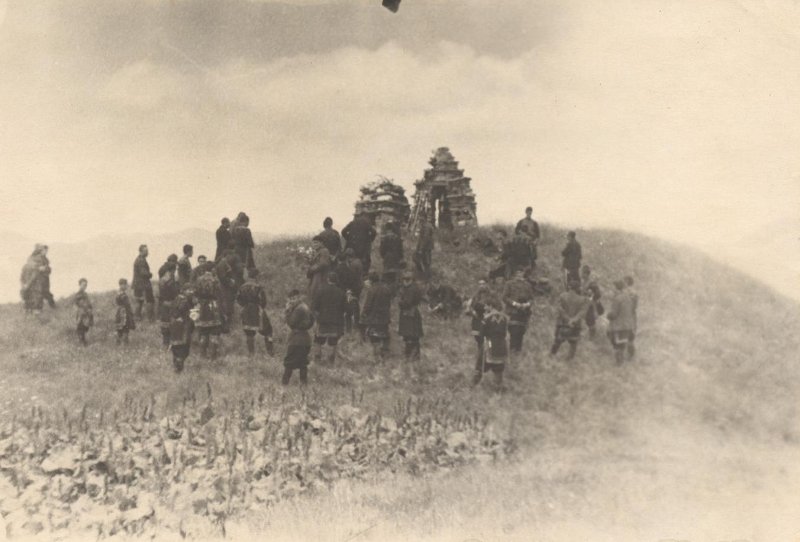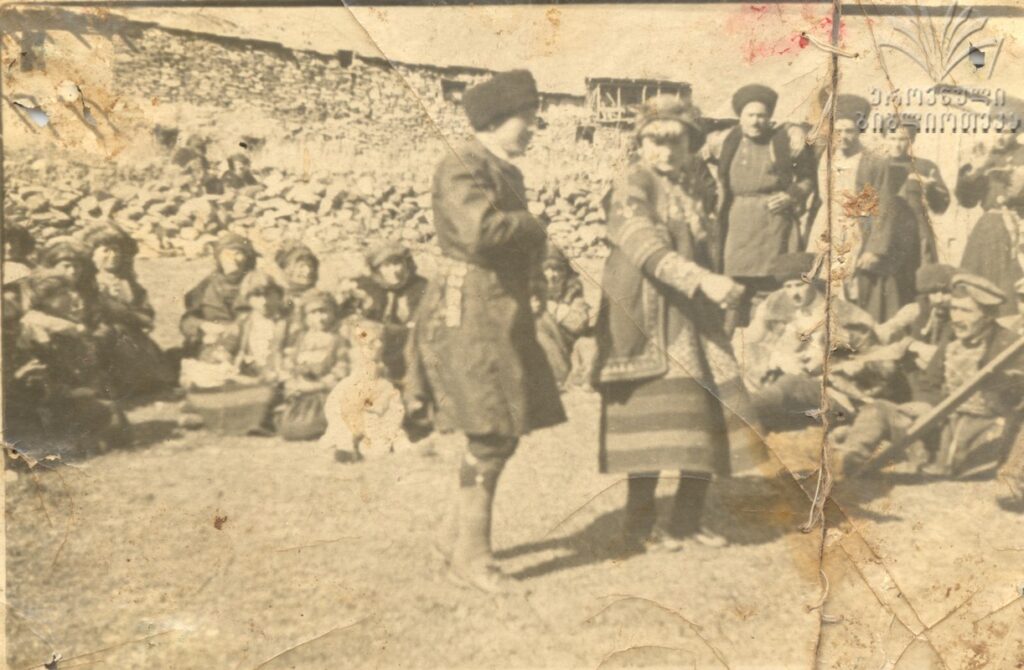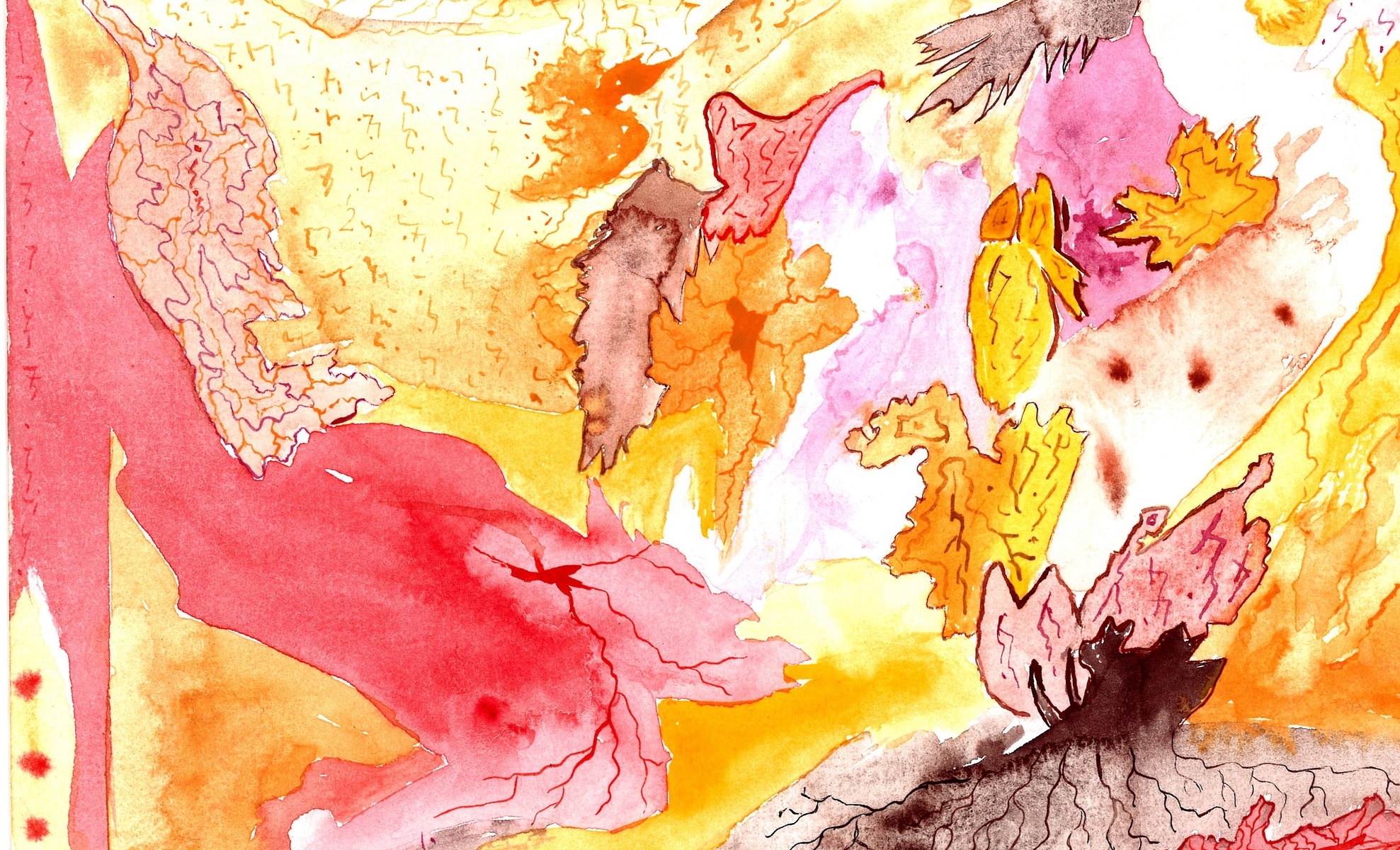
The Research Project in the Georgian Highlands
Due to their remote placement in the highlands of Georgia, the Khevsuretians have kept many ancient customs, rites and practices that have been dimmed or demolished in the lower Georgian areas through historical layers of colonialism and imperialism. I wanted to explore about my land in more depth and decided to go to the places were indigenous knowledge has been kept for the longest. Thanks to the mobility grant of Culture Moves Europe , I was able to initiate a research project, that focused on the ancient profession of the Qadagis. The research project pertained visiting 20 pre-Christian shrines of local deities throughout the Pshav-Khevsuretian mountainous areas and inquiring about the Qadagi people. The Qadagis were considered as the “tongues of the Gods” and served as an important link between the shrines and the human community. Let me introduce you here to the Qadagis.
Who are the Qadagis?
In the Khevsuretian culture the Qadagis/ ქადაგი were called the “tongues of the Gods”/ “მეენე”1 because of their role as seers and speakers of the divine. Their role in society was similar to the Sibyls of Ancient Greece.2 The Qadagis received messages, visions and guidance from the deities. They were given explanations about individual and public ailments and obtained insights about the possible remedies to the causations. The Qadagis were prophets. Their prophetic abilities within the Khevsuretian culture were specifically tied to the local deities. In Khevsureti often the reason for possible misfortune or illness was linked to conscious or unconscious mistreatment of the local protector deities and their sacred places. The Qadagis would gain intelligence about what needed to be done to mend the problem. They would understand what offerings needed to be made and what kind of changes needed to be enacted by the people.

The Captured Ones by the Gods
The Qadagis didn’t chose their vocation. It was in fact a rather undesired profession in Khevsureti. A highly regarded figure within the society, but not really a popular job prospect. The Qadagis would be also called “the captured ones by the Gods”/ “დამიზეზებულ-დაჭერილნი”.3 It seemed from the outside that they didn’t have will. They had to sacrifice often a “normal”, or perhaps more accurately named, a comfortable life. The people who were chosen by the shrines often resisted at first. But the visions wouldn’t stop, they would be plagued by prophetic dreams in their sleep and when the information would come through anyway, they’d often fall into seizures before finally the volcano erupted. As it is described in the legacy texts they couldn’t escape their fate and succumbed to their vocation after all. As soon as they brought the message, that needed to be voiced to the people their nervous system calmed down again and they found peace. At least until the next time they’d need to channel again the Gods.
How did the Ritual Look Like?
The process of the Qadagi ritual is described as a rather severe experience. When the Qadagis would get into contact with the deity, they had first a painful prelude. They started to tremble, to run around wildly, they fell into seizures and only after a long build-up the Qadagi finally voiced the message. The message came in a nine-syllable rhythm4 and was spoken in song. The language was foreign to the people. They called it “the shrine language”/ “ჯვართ ენა”.5 After the message was birthed the Qadagi translated themselves what had been said into common language, so that the people could understand.6
Who was Chosen as a Tongue of the Gods?
People were confused and couldn’t really explain the parameters by which the shrines chose their “tongues”. The Qadagis where often simple people with no particular heroic traits, or they were outsiders, or handicaps, or people with tragic backgrounds, sometimes the chosen ones were even children, and in the earlier stages particularly they were often women. In fact, the very fist Qadagi was a woman.7

The First Qadagi was a Woman Named Minani
The first Qadagi was a woman named Minani. The story takes places in the 4th century A.C. according to Gia Liqokeli, who is a descendant of Minani. Gia and his family are the only ones remained in the village Tschalissopeli, located in the Liqoki gorge in Khevsureti. They live in their ancestral village and continue their legacy of tending to the shrine of Kopala. Kopala is a local deity of war and protection, who has an abode in several places in Khesvureti in the form of shrines. In the creation story of the “shrine-birthing”/ “ჯვართ ჩენა”, it was Minani who established a shrine for Kopala and thus brought Him down to the earth. As such she counts as the first Qadagi who’s primary service is directed and connected to the shrine.
The Creation Story of the “Shrine-Birthing” on the mountain Karati
In the Khevsuretian legacy texts called “Andrezi”/ “ანდრეზი”8 we find several variations of the lore about the “Shrine-birthing” on the mountain Karati. All of them share the main storyline. The story goes like this:
A young couple, who love each other with pure love, meet in the summer times on the peak of the Karati mountain. The mountain divides the regions Khevsureti and Pshavi. The girl comes from Tschalissopeli, which is on the Khesvuretian side of the mountain. The boy is from the village Balaurta, which is on the Pshavi side of the mountain. On one day they hear shrieking sounds from the heavens. That is followed by a miracle: They see a cup and a Shibi out of silver descending from the heavens (Shibi is in Khesvuretian mythology a chain that connects the heavens and the earth.)9 The girl will take the Shibi and the boy the cup. They will agree to not share what happened with their parents. The boy hides the cup on the second floor of his house behind a door. The girl hides the Shibi in a bread container. In the night in both of their houses start the very same cries and shrieks like at the peak of mountain Karati. When this repeats again on the next day, the couple will confide their secret to the parents. The parents go to a medium and following the medium’s advice, they cut the chain into two pieces. They bury one piece at the place where the objects fell from the sky, the other piece gets buried in Liqoki and gets a tower build on top. The cup gets enshrined on the peak of the mountain Karati. These are the places of the shrine-birthing. From here on the girl named Minani will become a Qadagi and creates also the shrines in Gudani, in Khakhmati and in other places.10

Where are the Qadagis today?
During my research I found that the last Qadagis were performing their practices in the 1970-ies. The question arises, why did the Qadagi profession seize to exist?
The locals repeatedly highlighted, that the deities chose the people, they came to the people. Nowadays it seems they don’t visit anymore. Then the question arises why do the deities don’t visit anymore? There is obviously not one answer, as the cultural practice of the Qadagi and the phenomena related to it are intertwined with complex historical and cultural layers. Even though the Khevsuretian people kept their indigenous ways and their communal structural formations for a long time, colonialism and cultural and religious imperialism got to them too.
Short Detour to Historical Layers of Recent Times
The Russian Tsarist imperia was the first to breach the highlanders. Then the communist politics dislocated the people from their ancestral lands. They exiled them to semi-deserts in the East-Georgian regions. Explicit explanation: To bring all land to good use. Implicit reason: To break the indigenous spirit, to break people’s connection to their land, their roots and their ancestors, thus to implant the communist futuristic plan successfully into Georgia. Then, after the fall of the Soviet-Union Georgia was in a severe identity crisis, so that the revival of the Christian religion was not only a fortunate welcome for opening up to spirituality again, but a necessary survival mechanism in order to regain a sense of cultural identity. The Christianisation then did also their part on overlaying Christian beliefs and values on local indigenous heritage. And then we have of course the global cultural imperialism of the “Global North” , that continues to expand its power of influence by superimposing their values on (post)-colonised countries.

Indigenous Practices Emerge in their Cultural Contexts
Coming back again to our question of why the Khevsuretians don’t perform the Qadagi practices anymore, we need to consider that every practice and profession emerges from its cultural context. The Qadagi’s function and meaning makes only sense in a structure that sees the value of such practices. The villages that formed around the shrines as communities offered such structures. Now the communities are not intact anymore, as there are only little numbers of families remaining in their ancestral villages. The inhabitant’s numbers have decreased tenfold during the last couple of decades.
Qadagi as a Broader Term
On the other hand, if we zoom out from the specific cultural framework of the Khevsuretian people, the question might not be accurate at all. The Qadagis might not have seized to exist. During our workshop, that I offered in Tbilisi as a succeeding element of the research project on the Qadagi subject, participants held the vision and inner knowing, that they were already embodying the Qadagi figure in their own ways. Even if it didn’t look specifically Khevsuretian-style. Perhaps the “Qadagi-ship” just changed its shape and form?
In that case another precaution arises. If there are still people living with similar fates to that of the Qadagis, we need to create safe spaces for them, so that they can survive our current globalised culture’s pressure sanely. We need frameworks to not disregard such phenomena as an insanity, but to give them the needed spaces and networks, so that they can be held through the intense convulsions. The people need to be held, heard and seen so they can bring their particular offerings and services to our today’s culture.
Mediumship and Sovereignty
Another important point is the question of sovereignty in relation to mediumship.11 This is especially the case if we consider, that the potential “Qadagis” today are probably not living in small communities anymore, where there is a framework for their visionings and abilities. We can not negate the environment and the culture that we’ve been born into. If it is a culture that is historically eclectic and culturally chaotic, but that has also a strong impact from more individualised perspectives and values of the “Global North”, then we have at least also the opportunity to explore our sovereignty more in depth. We need to be cautious when we don’t have certain scripts anymore. Especially a sacred practice like the Qadagi’s, that involves trance-states and mediumship needs to be met with self-aware tenderness. We can be practicing mediumship and have our sovereign will at the same time.
Sources & Remarks:
- Ochiauri Tina, Ancient Georgian Religions, Tbilisi 1954, pg. 5.
- Ochiauri Tina, Ancient Georgian Religions, Tbilisi 1954, pg. 10.
- Tavdgiridze Khatuna, Lecture on Georgian Mythology, Youtube video in Georgian language: https://www.youtube.com/watch?v=S3XGeaegwPk
- The 9-syllable rhythm is a specific metric in Georgian folklore, that is typical for the genre “Mtibluri”/ “მთიბლური”. The Georgian “Scything Songs”/ “გვრინი” are a good example of this genre. The Georgian lamenting practice “Lament in Voice”/ “ხმით ნატირალი” shares the same metric as well. You can read more about “Lament in Voice” in this Article and more about the “Scything Songs” in this Article.
- Ochiauri Tina, Ancient Georgian Religions, Tbilisi 1954, pg. 128-135.
- It is remarkable, that the Qadagi seems to stay conscious even though they go through a severe process of trance and is possessed by the Gods. They remember what they speak in the trance and can translate it themselves afterwards.
- Kiknadze Zurab, Georgian Mythology 1, Cross and its Community, Tbilisi 2016, pg. 170.
- Kiknadze Zurab, Andrezi, The Religious-Mythological Oral Traditions of the Highland of Eastern Georgia, Tbilisi 2009, pg. 58-61.
- Shibi is also the reason why I called this page Shibianta
- Kiknadze Zurab, Georgian Mythology 1, Cross and its Community, Tbilisi 2016, pg. 170.
- The ritualist Maris Bergrune has a great range of work around the topic of mediumship with conscious resonance. You can visit her article about this here.
